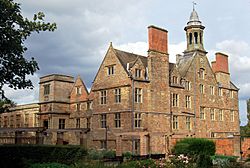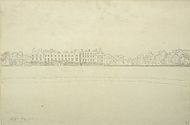Rufford Abbey facts for kids
 |
|
| Monastery information | |
|---|---|
| Order | Cistercian |
| Established | 1147 |
| Site | |
| Location | Rufford, Nottinghamshire, England |
| Coordinates | 53°10′31″N 01°02′08″W / 53.17528°N 1.03556°W |
| Website | http://www.ruffordabbey.com |
Rufford Abbey is a large country estate located in Rufford, Nottinghamshire, England. It is about 4 kilometers (2.5 miles) south of Ollerton.
This historic place started as a Cistercian abbey in 1147. Later, in the 1500s, it was changed into a country house. This happened after the Dissolution of the Monasteries, when King Henry VIII closed many religious houses.
Today, part of the house is gone, but the remaining buildings are in a beautiful 150-acre park. This area is now open to everyone as Rufford Country Park. Part of the park is also a special place called a Local Nature Reserve. The house itself is made from stone, brick, and tiles. It is a very important historical building.
Contents
The Abbey's Beginnings
The abbey was first built on July 12, 1147. It was founded by Gilbert de Gant, Earl of Lincoln. Cistercian monks from Rievaulx Abbey in Yorkshire came to live there.
In 1156, the English Pope, Adrian IV, gave his blessing for the abbey. After this, the abbey's land grew much larger. Sadly, this meant that villagers from Cratley, Grimston, Rufford, and Inkersall had to move out. A new village called Wellow was built nearby. Some of the people who had to leave their homes moved there.
When the monasteries were closed in 1536, the last abbot, Thomas Doncaster, was supposed to get a pension. However, he quickly became the rector of Rotherham, so he didn't need the pension.
After it was closed, people started to say that the abbey was haunted. They told stories of a giant monk ghost carrying a skull!
Leaders of the Abbey
Here are some of the abbots who led Rufford Abbey over the years:
- Philip de Kyme (around the time of King Stephen)
- Edward (1203)
- Geoffrey (around the time of King John, 1218)
- Thomas
- Simon (around 1232)
- G— (around 1239)
- Geoffrey (around 1252)
- William (around 1259)
- Henry (1278)
- Thomas de Stayngreve (around 1283)
- Henry (around 1288)
- Henry de Tring (around 1315)
- Elias Lyvet (Levett) (around 1332)
- Robert de Mapelbek (1352)
- Thomas (1366)
- John de Harlesay (1372)
- John de Farnsfeld (1394)
- Thomas Sewally (around 1400)
- Robert de Welles (1421)
- Robert Warthill (died 1456)
- William Cresswell (1456)
- John Pomfrat (died 1462)
- John Lilly (1462)
- John Greyne (1465)
- Roland Bliton (1516)
- Thomas Doncaster (the last abbot)
Rufford as a Country House
After the abbey was closed, the estate was given to George Talbot, 4th Earl of Shrewsbury. Between 1560 and 1590, his son, the 6th Earl, changed the abbey into a country house. He had parts of the old abbey torn down to make way for the new home.
In 1626, the estate went to Mary Talbot. She was the sister of the 7th and 8th Earls. Mary and her husband, Sir George Savile, 2nd Baronet, then owned Rufford. Sir George Savile updated the house between 1685 and 1695.
Sir William Savile, 3rd Baronet, who was George's son, made Rufford Abbey the main home for the Savile family. He did this after burning down their old family home. He wanted to stop Parliament's army from taking it during the English Civil War. Sadly, Sir William was killed in battle in 1644.
Next, his son, the Marquess of Halifax, lived there. He was a very important government official. In 1679, he added a new north wing to the house. This part had grand rooms and a long gallery. He also built the large stable building you can still see today. The part of the house now used as offices was also added by the Saviles in the 1600s.
Over the years, the estate passed through many hands in the Savile family and related families. By the early 1900s, the Rufford Abbey Estate was very large, covering about 18,500 acres (75 square kilometers). However, it became very expensive to run. In 1938, the estate was sold off in smaller pieces. Sir Albert Ball bought much of the land. He then quickly sold the house to a unique person named Harry Clifton.
In 1952, Nottinghamshire County Council bought the abbey and 150 acres of its land. In 1956, some of the newer parts of the house were taken down. The remaining old parts were then looked after by the government. Today, Rufford Country Park is open to everyone. It is one of the most visited places in North Nottinghamshire.
History of the Rufford Area
The area of Rufford was mentioned in the Domesday Book. This was a famous survey of England made in 1086.
The Rufford Estate was very large. It covered about 29 square miles (75 square kilometers). Besides Rufford itself, it included many nearby villages and parishes. These included Bilsthorpe, Eakring, most of Ollerton, Ompton, Boughton, Wellow. It also stretched into Blidworth, Edwinstowe, Egmanton, Farnsfield, Kirton, Tuxford, and Walesby.
The old titles of Lord of the Manor of Rufford and of the Liberty of Rufford were sold in 2010.
Ice Houses at Rufford
Between 1729 and about 1845, many improvements were made to the Rufford estate. For example, a bath house was added. A lake and mill buildings were created. A brewhouse, water tower, and coach house were built. Also, five special buildings called ice houses were added.
Even though Rufford Abbey once had five ice houses, only two are still standing today. All of them were built around 1820. At that time, the estate was owned by John Lumley-Savile, 8th Earl of Scarbrough. The ice houses were built near Rufford lake, which was created around 1750. This was because it was easier to move ice from the lake to the ice houses.
Not all of Rufford's ice houses faced north. This is because it was more important for them to be easy to get to. It was also important to make it simple to bring the ice inside. Builders often placed the doorways facing the lake for this reason. People believe that most of the ice came from Blackwalk Pond. This pond was later drained to build houses in the 1900s. Blackwalk Pond was used to supply water to the abbey when it was a monastery. Later, it supplied water to Rufford's water tower and brewhouse, which are still there today.
Rufford Abbey on TV
Rufford Abbey was the setting for a children's book by Helen Cresswell in 1984. The book was called The Secret World of Polly Flint. Later, in 1987, it was made into a TV series with the same name. The small village of Wellow, which is next to Rufford, was also used in the show.
Images for kids
See also
 In Spanish: Abadía de Rufford para niños
In Spanish: Abadía de Rufford para niños





